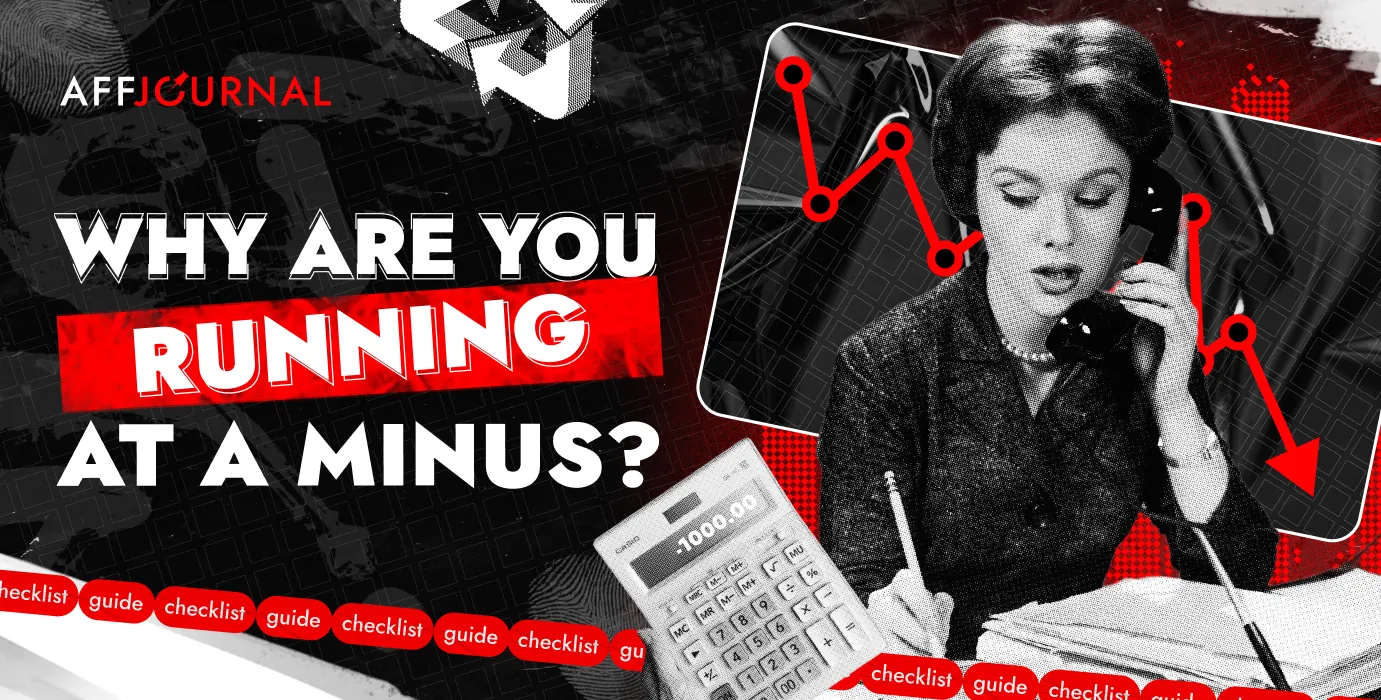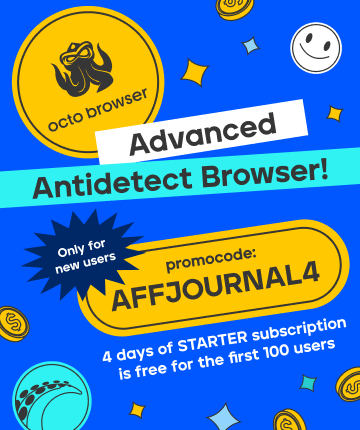

by Editor
Many newcomers panic when faced with negative returns, often considering quitting affiliate marketing altogether. Let's discuss whether to continue investing, what to analyze and verify. By learning from mistakes, removing emotions, and identifying the causes, valuable insights can be gained. Our checklist will help thoroughly dissect your campaigns and shed light on what went wrong and led to failure. Let's go! 🚀
Remove emotions
Losing a budget on an unsuccessful campaign can happen not only to a beginner. In other words, the first failure doesn't necessarily mean that "everything is bad, marketing is not for me at all...". On the internet, you can come across anticases of entire teams where experienced individuals share how they lost thousands of dollars in budgets. Undoubtedly, failure can be very demotivating, especially for someone who has just started in CPA. But only those who do nothing don't make mistakes. Every person learned to walk in childhood, fell many times, but found the strength to get up and keep going.
If your goal is indeed to succeed in affiliate marketing, to earn well, failure should not undermine your self-confidence. It's important to look at what happened with a clear head, to abstract away from emotions. This is the first step. CPA marketing is stressful work, like any business, and it's important to use your brain.

Keep calm
Once you've managed to deal with your emotions, you can move on step by step, thoroughly analyzing each stage of the campaign.
Answer the question: Is the data sample size sufficient
If the failure and setback occurred only within the first few minutes of the campaign, there’s no reason to panic. Perhaps there are not enough clicks collected, or the algorithms need more time to learn.
Example: A negative balance equal to the payout of the offer occurred, but you still have hypotheses and creatives. Therefore, a sensible step would be to conduct additional tests and check the remaining hypotheses. It's impossible to judge whether a campaign is successful or not based on just a few clicks. At least 1000 clicks are needed to determine if it's working or not.
Analyze the numbers step by step and sequentially
The data about the campaign and its progress are displayed in the traffic source in the ad account, in the affiliate program, and in the tracker. What figures do we analyze:
- ROI. In case of negative ROI, it's necessary to check the technical aspects. For example, a link could be broken, something might have happened to the tracker, domain, redirect, or API. It's preferable to check this before starting the campaign. However, some newbie webmasters in their haste and eagerness to start running traffic as soon as possible might overlook something, so the possibility of technical issues should be kept in mind. If everything was checked and working, but it turns out that it stopped working, you can contact the traffic source manager or support service to find out how to solve the problem.
- CTR. There are no universal figures for what CTR is considered good. For some offers, 0.1% may be decent, while for others, 10% could be disastrous. To determine the optimal CTR, you can study publicly available information from cases related to your offers and categories, and compare them with your other campaigns and periods. If it becomes clear that the CTR is low, it's necessary to refine the creatives: rewrite the headline, text, or add a different image.
If the CTR is at an acceptable level, then the loss of traffic is more likely to occur on the landing page. In this case, we keep the creative and move on to examining the landing page. We check for any deceit, inconsistencies, inaccuracies, or discrepancies in the texts.

CTR
CR. After analyzing your CTR, you need to analyze all conversions based on your sales funnel. For example, if your funnel consists of a creative — pre-lander — landing page, then you should study the CR at each stage. This is necessary to identify bottlenecks where customers are lost. Some webmasters consider a 20% conversion rate from the pre-lander to the landing page as optimal: meaning, one out of every five visitors from the pre-lander ends up on the landing page. You can take this figure as a benchmark and always strive to increase it.
How to understand what to change — landing or pre-landing page:
- if there are few visitors transitioning from the pre-lander to the landing page, and the CR is below 5%, then the problem clearly lies with the pre-lander;
- if the CR from the pre-lander to the landing page is normal but people aren't making any orders, then the landing page needs to be refined.
What problems can be on the landing page:
- misrepresentation, discrepancies in information between the creative and the landing page;
- violation of logic on the landing page;
- incorrect translation, semantic errors that are read by native speakers as gibberish;
- technical problems such as a non-working lead form, non-adaptive design, and layout issues.
Understand what's wrong with approval
When the campaign numbers have been analyzed, it’s necessary to understand what happens to the lead after they submit the order form. Almost any affiliate program indicates the AR for the offer. You can use this as a reference to compare your numbers. For example, if the AR is stated as 50%, it doesn't mean that every second order is confirmed. One webmaster may have a 100% approval rate, while another may have 10%.
If it turns out that the actual AR is low, it's important to understand the reason. For example, the issue could be with the quality of traffic or with the product's specifics. In any case, it's necessary to contact the affiliate program manager, explain the problem with the low approval rate, and seek advice on why this is happening.
Analyze the combination for burnout
The situation could be: the webmaster was successfully running for some time, and suddenly the combination stopped working. Then you should check the parts of the combination:
- Target audience. Burnout can occur because the creative has been running for a long time and ends up being shown to the same users repeatedly. To reach a new audience, you can use different targeting settings or choose another traffic source.
- Creative. In many sources - advertising networks, push networks, TikTok - creative needs to be changed frequently, literally every day or once every couple of days. If you're too lazy to change the creative - burnout happens.
- Offer. It may be that the product is familiar to the audience, they’ve bought and used it, so they no longer react to the advertisement. In this case, you can promote the old offer in a new source or vice versa, take a new product and promote it in a familiar source.
When a previously successful campaign starts running at a loss overnight, there may also be technical issues. For example, the domain may have been blocked, the URL may have been broken, or simply ran out of funds in the account.
Become aware of your strategy and approach
Beginner webmasters often face failure due to incorrect beliefs or ignoring the importance of testing, gathering and analyzing information. Example of a false belief: "CPA is easy!" Reading numerous articles, a novice thinks that they can simply take an offer, copy creatives from the first pages of spy services, set up 1-2 ad groups, and wait for profit. In other words, there is no study of the offer, GEO, target audience, no formulation of hypotheses for different approaches, no calculations are made, and even a tracker is not installed.
The approach to marketing and strategy for promoting offers should take into account several aspects comprehensively:
- In-depth audience research. It's essential to know everything about your client: who they are, the culture in their country, how they respond to advertising, their pain points, preferences, priorities, and more.
- Understanding the offer and the specifics of the category. For example, when the webmaster starts working with Vision offers, it's crucial to understand how to promote such products in the GEO, what form factor is relevant, how to capture people's attention, the benefits, composition, discounts, delivery, and other perks.
- Mathematics of expenses and revenues. Ideally, a webmaster should be familiar with the calculator and constantly calculate: how much money to spend on testing, how much on consumables, how much revenue is expected according to forecasts, and so on.
- Exploring different approaches and hypotheses. For example, a webmaster is working with a weight loss offer and finds out that News, Interviews with a doctor, and Drawing graphics are popular in the GEO. For each of these 3 approaches, it's necessary to prepare at least 5 creatives for testing to verify all hypotheses.
Only comprehensive analytics and systematic preparation will help reduce the risks of your first campaign being a failure. Don't trust the info scammers who supposedly guarantee that affiliate marketing is so easy that even a person with no experience can "rake in money with a shovel" today.
If you analyze interviews and data from open sources, on average, a webmaster loses money or breaks even during the first six months. While going through a series of mistakes and learning from practice, the webmaster gains experience and insights that will help recoup losses and start turning a profit. It’s important to constantly analyze metrics, conduct tests, and treat mistakes as a source of valuable practical information.
Conclusion
If a campaign results in a loss, it's a lesson that will help turn the next campaign into a profit. What may seem like a failure at first glance can provide valuable insights into traffic sources, creatives, target audience, and approaches. In affiliate marketing, as in any business, a mistake can be seen as a resource for achieving success.
Wishing you success, profit, growth, and only fruitful work without losses!

by Editor



comments ....(0)
Leave a comment
You must be in to leave a comment